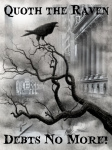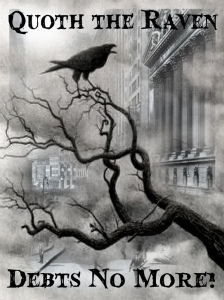submitted by jwithrow.
Journal of a Wayward Philosopher
Raising Children in the Modern World
December 17, 2014
Hot Springs, VA
The S&P opened at $1,972 today. Gold is back down to $1,198 per ounce. Oil is down to $56 per barrel. Bitcoin is down to $322 per BTC, and the 10-year Treasury rate opened at 2.08% today.
Both oil and the 10-year rate are closing out 2014 at price levels much lower than most analysts anticipated which sets up for an interesting 2015. Will crude prices remain at current levels and put the squeeze on the U.S. Shale revolution? Will interest rates remain low and complicit in enabling the Treasury to service the $18 trillion national debt without much fuss? We shall see.
As for the S&P, it has been 6 and a half years since it experienced a correction of 10% or more. But markets cannot go in one direction forever – that 10% correction is coming. I have seen some predictions of a major 10%-plus correction sometime in the spring of 2015. It may be more like 50% if the correction is coupled with the fiat monetary crisis that is on the horizon but I think we may still be a few years away from that one. Instead, it is more likely that a major stock market correction will spur the Fed into QE4. Either way, it is advisable to be very vigilant if you have money in the equity markets.
Shifting gears, I have been thinking quite a bit about child-rearing given the arrival of Maddie Lynn eight weeks ago. I have come to the conclusion that our culture today has become much too rigid and regimented when it comes to raising children in our fast-paced modern world.
School days have gotten longer, homework loads have increased tremendously, grades are now emphasized heavily, standardized testing has been implemented and enforced across the board, the number of adult-organized activities for kids have exploded and, as a result, childhood stress, worry, and fear have increased dramatically.
Studies conducted by Jean M. Twenge at San Diego State University suggest that youth anxiety and depression have been trending higher rather sharply over the last fifty years. Perhaps more troubling, Twenge’s research suggests a shift in motivation amongst kids from intrinsic to extrinsic values; kids now tend to be more motivated by popularity and money than self-acceptance, moral character, and community.
The reason for this shift is rather clear to me: American childhood is now more about meeting adult expectations and less about personal growth and development. Observe the parents at a youth sporting event and see if this statement isn’t true. Now the parents mean well, don’t get me wrong. But too often they think their child’s future depends exclusively upon performance in school, performance in athletics, performance in extra-curricular activities, or some other external measurement of performance so these things are all pushed on kids to the point where their own interests and talents are subordinated.
Studies by Peter Gray show that childhood free time has been declining steadily since the 1950’s including a decrease in free play as well as time spent talking to others at home. Meanwhile, time spent on homework has increased 145%.
The government school system equates more homework with more learning. In reality, homework serves only to replace students’ individual interests with the Department of Education’s mandated curriculum. At best students memorize the mandated curriculum long enough to pass the standardized test and then they let it go. At worst they think the curriculum is useful and they retain it at the expense of pursuing their own passion. The truth is memorization is not learning; it is a waste of time and energy.
Real learning can only occur when the individual has an interest in the topic and is free to explore that topic in his or her own way. Children need to be free to make mistakes, analyze those mistakes, and then attempt to correct the mistakes. Instead, the current model of education teaches children that they will be judged and punished if they make a mistake so students learn to fear mistakes above all else. This mentality has the potential to set them up for a very restricted adulthood in which they shy away from opportunities for fear of making a mistake.
Ultimately we need to ask ourselves what is truly important for our children. This will be different for each family and that should be embraced, not ridiculed. There is no reason to think everyone must adopt the same parenting style or that every child must receive the same education. In fact, a free society requires diversity and the sharing of unique ideas in order to thrive.
So what’s really important for our children?
Good grades and getting into a good college? This looks like an outdated model to me – it is exclusively designed to produce good employees. But we are moving away from a ‘jobs’ based economy and the availability of traditional full time employment with comprehensive benefit packages will continue to diminish over the coming years and decades.
Becoming a superior athlete? My observations suggest that youth athletics are much more important to the adults – school employees, coaches, parents – than they are to the kids. Too often youth sports are a chore rather than a joy.
Participating in as many extra-curricular activities as possible? Again, these are often more important to the adults than the kids. Children should certainly be free to participate in whatever groups or activities interest them but too often they are pushed in the adult’s favored direction instead of their own.
I am convinced that a childhood free to grow and develop in a unique way is the most important gift parents can give their children. I think children need more guidance and less teaching; they should be encouraged to discover and pursue their own passions and interests without the pressure of forceful expectations. Pair this method with sound financial education and an IBC insurance policy that has been capitalized for 18 years and I think you have the makings of a creative, self-driven adult capable of thriving in a rapidly changing world.
Of course these are just this philosopher’s humble opinions.
Joe Withrow
Wayward Philosopher
For more of Joe’s thoughts on the “Great Reset” and the Infinite Banking Concept please read “The Individual is Rising” which is available at http://www.theindividualisrising.com/. The book is also available on Amazon in both paperback and Kindle editions.



